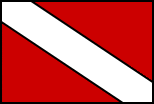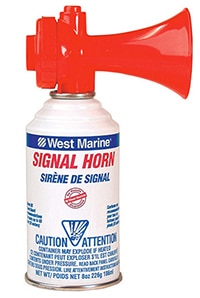Non-Electronic Communications
Sailing has been around for thousands of years. Electronic Communications has been around for less than 100 years (not counting the telegraph).
The Slow Old DaysMy Dad was a radio operator on a DC-3 aircraft during WWII. His stories of communicating using Morse Code were boundless from gaining the landing patterns to communicating emergencies like their landing gear not coming down or the tail-plane had been shot up. He was a pioneer user of the new age of Morse Code communication. Today we can’t even imagine that slow of a data rate. Some of us used to use 14.4k dial-up modems. Argh! |
Before the harnessing of electrons and radio waves, humankind used many other forms of communication. Many are still used today.
Forms of non-electronic communication include:
- Verbal
- Hand signals
- Flags and pennants
- Sound-making devices such as bells, horns, sirens, whistles, and cannons
- Megaphones—just an improvement on verbal
- Flares
Each of these forms has unique uses depending on the situation. Yet most require users to understand their meaning. Even with verbal communication, you have to be careful because of all the terminology.
Verbal Communication
Unfortunately, many a newbie sailor has been turned off sailing by a few crusty captains because of their harsh verbal communication style (AKA abuse). Don’t be a crusty sailor. Below are a few people skills inserted into this course.
A loud clear voice is often preferred to gain the attention of someone not looking. For example, you might announce “STARBOARD” in a potential sailboat-on-sailboat collision situation. By stating this, you are stating that there is a close-quarters situation, that collision is possible, and that you are stating you are the stand-on vessel—all in one word. As master of the vessel, it is your responsibility to state this loud and clearly: the other boat might not have seen you, they might be completely unaware of the rules, or they might believe they can squeak by.
A hasty, unknowledgeable, and surly skipper might yell out “$#@%^ get out to the way I have right of way” which serves no clear purpose. On the water, there is no room for road rage. Actually, in life, there is no room for road rage – take a personal development course!
It is also your responsibility to understand such communications before you assume the role of skipper of a vessel.
Yelling is unacceptable. Instead, a loud, clear voice is acceptable. We say this because the word yelling has a negative connotation. And creating negative situations only heightens emotions. We are all familiar with road rage and the truthful person would admit that they, at some time, have been guilty of it even to the slightest degree. If you’ve ever shot the bird at someone—the finger—then you have been suckered into your negative self.
We address yelling and road rage (on the water) here in more detail because it’s important. Despite the wide expanse of the ocean, there is no room for negativity on the water.
Viktor Frankl, a WWII concentration camp prisoner and renowned psychiatrist, developed the notion of logotherapy, the theory that we try to attach meaning to everything. We attach meaning to someone cutting us off in traffic; we attach meaning to being on the receiving end of the bird; and we attach meaning to being yelled at. Steven Covey, in his popular book The Seven Habits of Highly Effective People, integrates Frankl’s notion and adds that we as humans have the ability to see an action, make a decision on how to react, and then perform the reaction. Animals, on the other hand, only have action followed by instant reaction.
As an example, let’s assume we get cut off in traffic. Humans have the ability to think about that, to make a decision about the meaning of that (if we want), and the ability to decide what to do about it. The key word is “ability.” It does not necessarily mean that we act upon what we think or decide. Just that we have the ability. What is it about someone cutting us off in traffic? What meaning do we attach to that? Did they do it on purpose? Maybe, maybe not. In most cases, probably not. Even in addressing the case that they did it on purpose, we still have the ability to decide “Should I let that person continue with their crappy day or should I teach him a lesson so he’ll never do that again in his entire life?” In the decision process, we get to bring in our human selves and decide that we don’t have to attach meaning to it; that it might have been a mistake, or that even if it was on purpose, who cares? Why let it ruin my perfect day?
The trick, Covey states, is to practice inserting ourselves into the decision before the instant animal reaction.
On the water, you’ll find there are a lot of inexperienced people out there. Novices, newbies, old hats who have not bothered to learn the rules, whomever— are all out there. But there is only one reason you are on the water and that is to enjoy yourself. To recreate = re-create. Re-create your good experiences. Don’t let others ruin your day. Make a decision to make a decision between the action and your reaction.
Instead of yelling “Learn the #@$% rules ya &*&^%,” which, as we all know, is only going to get you the finger in return, you might buy the guy a drink back at the yacht club and say something like, “Whew that was a close one out there. I thought I was the stand-on vessel but perhaps I was wrong. What were your thoughts?”
Another way of looking at this is to put yourself in their shoes. Have you ever made a mistake in traffic? Well, maybe that was you in another body making a mistake. It was a wise man many years ago who said, “Let he who is without sin cast the first stone.” We all make mistakes. Let it go.
The point is to act like Abraham Lincoln, who was known as a great leader because of his leadership skills, not because of his title. What are your leadership skills at the yacht club or on a boat? People will follow you on a boat because they think (even unknowingly) that you are a good leader. It’s not because you are a self-proclaimed captain; it’s not because of your experience. In the corporate world, people go back to work the next day under a bad leader because they have a job to try to keep. On a boat, you will find out about the quality of your leadership skills pretty quickly by the number of your solo sailing days. In the corporate world, you can expound upon your experience, berate, and belittle as much as you want; on a boat, it’s back to solo sailing if you behave like this.
We really encourage you to read this article on our blog site on how to be a good leader on a sailboat.
Take, for example, the yeller, the skipper who yells at his crew, his spouse, and his friends. This is just a bad leader. “But,” the skipper says, “it was necessary, we were about to hit the dock.” The best way to hit a dock is to freeze up your crew by yelling at them. If you use an authoritative clear loud voice with specific instructions you will get things done smoothly and perfectly and maintain or even increase the respect you get. For example, “Mike. We are going to hit the dock. Please take this fender now and go up front. Put it between the boat and the dock so we don’t crash into it. Thanks.”
Back to using a loud clear voice, think about your audience. Can they understand what you are saying using the terminology? Can they even hear you? A classic case where communications are compromised is between the bow and the helm station; it is nearly impossible in the wind. Hand signals are preferred, although bigger and more sophisticated boats use microphones and earpieces.
A final word on this is: neurologically, it has been proven that our brains go into stall mode if we are being verbally attacked. We can’t think or act. The dear caught in the headlight syndrome. If you want your crew to act on something, the worst thing you can do to try to get them to act is to yell. To get something done quickly and efficiently, give clear and very specific instructions. If you yell, you are a bad skipper!
Hand Signals
There are universal signals that work for most people, but it is a good idea to agree upon a set of hand signals that work with your crew.
Below, the foredeck crew member is simply pointing to where the anchor lays on the bottom so that the helmsperson can slowly steer the boat to a position directly above the anchor. A closed fist means to stop the boat in place.
Using Hand Signals
Important ones:
- A closed fist stops the boat in place or stops what you are doing
- An open vertical hand puts the engine in neutral.
- Vertical hand with a second horizontal hand creating a T shape for time out—wait a second or so.
- Crossed arms in an X with closed fists is to make fast— lock it off—cleat it.
- A flat open horizontal hand pumping slowly up and down is slow down.
- A flat open vertical hand pushing aft stops the boat in the water and back up a little.
- When retrieving an anchor, the bow person points to the anchor so the helmsperson can steer that way.
- A hand with flicking open and closed fingers means easing that line (let out slowly).
- A twirling upward finger means to bring in that line.
- Patting yourself on top of the head means OK (taken from scuba diving).
Start using these on your boat with your crew and stay consistent with their use. Pretty soon you’ll be easily communicating with your regular crew.
Watch this video from our friends at Yachting Education…
Video Hand Signals
Flags and Pennants
Flags and pennants are not used extensively. The most important ones to know are diving flags. There are other flags are used for emergencies and these are covered in Chapter 11: Safety and Emergencies, under the Raising the Alarm section.
Diving
You need to be aware of two diver-down flags that indicate the vessel has scuba divers below. You are required to stay 300 feet (100 meters) away from such a vessel.
In the USA the red flag with a white strip is used
In most of the rest of the world, the Code A flag is used
Sound-Making Devices
Sound-making devices are extensively used as warning devices and for maneuvering announcements on larger ships.
An important note is to always have a loud horn accessible within 1 to 3 seconds to the helmsperson. This simple self-imposed rule WILL prevent a collision at some point in your sailing life. Maybe tomorrow, maybe next year – who can say when?
Sound Horn
Flares
Flares are used in emergency situations. This topic is covered in Module 11: Safety and Emergencies, under the Raising the Alarm section.









